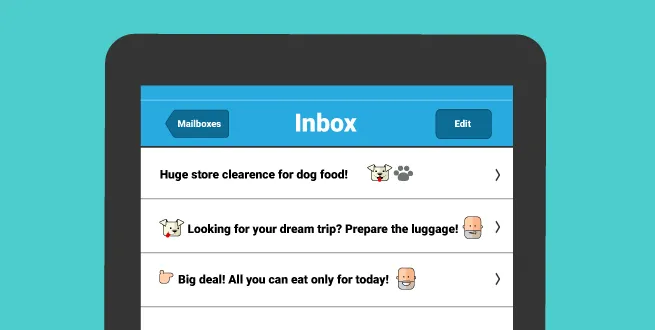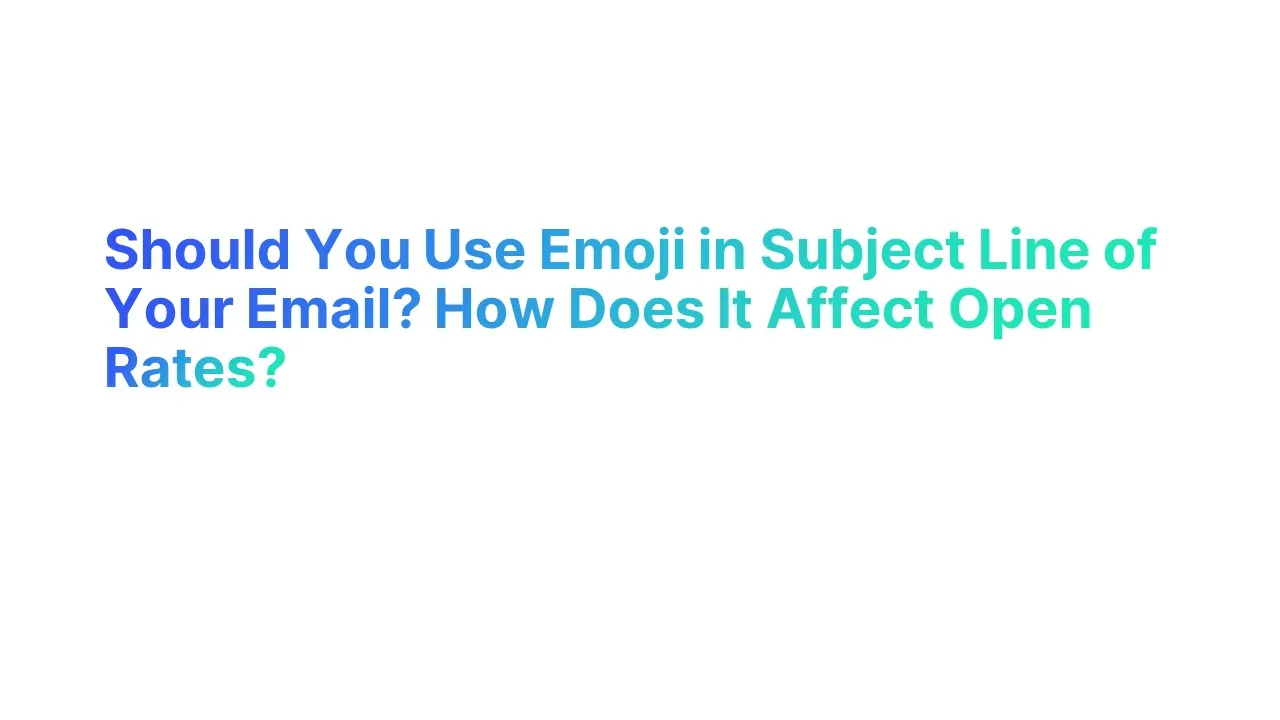Introduction to Emojis in an Email Subject Line

Incorporating emojis into email subject lines is an innovative strategy to capture recipients' attention in a crowded inbox. Research indicates that emails with emojis in their subject lines have a higher open rate compared to those without. This is because emojis add a visual appeal and convey emotions effectively, making the email stand out.
The Impact of Emojis in Subject Lines on Email Performance
The impact of using emojis in subject lines on email performance is profound and multifaceted. Emojis not only grab attention but also enhance the recipient's engagement with the email, influencing open rates, click-through rates, and overall campaign effectiveness.
1. Open Rates
Increased Visibility
- Emojis make subject lines stand out in a crowded inbox, increasing the likelihood of your email being noticed. This visual differentiation can significantly boost open rates.
- For example, a report by Experian found that emails with emojis in their subject lines can increase open rates by up to 56% compared to those without.

Cross-Platform Appeal
- Considering mobile devices account for a significant portion of email opens, emojis are particularly effective in capturing the attention of mobile users, where space is limited and visuals are more impactful.
2. Click-Through Rates (CTR)
Improve Engagement
- By conveying emotions or intentions more effectively than text alone, emojis can make an email feel more personal, fostering a connection that encourages recipients to not only open the email but also to engage further with its content.
- This can lead to improved click-through rates, as recipients are more invested in exploring the email's contents. A study by Campaign Monitor showed that adding just one emoji to your subject line can increase engagement by up to 50%.
Contextual Relevance
- When used appropriately, emojis can summarize the email's purpose or highlight special offers, events, or urgency, encouraging recipients to click through to take advantage of what's being offered.
3. Brand Perception
Personality and Tone
- Emojis help convey your brand's personality and tone, making your communications feel more human and relatable. This can strengthen brand affinity among your audience, as they perceive your brand as more approachable and understanding of their needs.
Audience Resonance
- The effective use of emojis can resonate well with certain demographics, particularly younger audiences who are accustomed to using emojis in daily communication.
- However, it's essential to understand your audience's preferences to ensure emojis align with their expectations and perception of professionalism.
4. Visibility in a Crowded Inbox
- With billions of emails sent daily, using emojis can help your email stand out, increasing the chance that your message gets noticed.
Statistics on Open and Click-Through Rates After Using Emojis in Subject Lines

Is It Professional to Use Emojis in Subject Lines?
Using emojis in subject lines can be professional if done correctly and in the right context. The professionalism of emojis depends on the audience, the industry, and the message you intend to convey.
For businesses with a more casual, approachable brand voice, emojis can enhance communication and make emails stand out in a crowded inbox.
Who Should Use Emojis in Email Subject Lines?
- Brands with a Casual, Youthful Tone: Companies targeting younger demographics or those with a more relaxed brand voice can use emojis effectively. Emojis resonate well with these audiences, who often use them in everyday communication.
- Consumer-Focused Businesses: Retail, entertainment, travel, and food industries can benefit from using emojis. These sectors often communicate deals, excitement, and fun, which emojis can encapsulate succinctly.
- Marketing Campaigns Seeking to Increase Engagement: Campaigns aiming to boost open rates and engagement may see significant benefits. For instance, a report by Experian stated that using emojis in subject lines can increase open rates by up to 56%.
Considerations for Professional Use of Emojis
- Know Your Audience: Understanding your audience is crucial. If your subscribers prefer a formal tone, emojis might not be appropriate. Conduct audience research or A/B testing to gauge how your audience responds to emojis.
- Keep It Relevant and Subtle: Use emojis that directly relate to your email content. Overuse or irrelevant use of emojis can detract from the message's professionalism.
- Test Across Platforms: Ensure emojis render correctly across different email clients and devices. Incompatibility could lead to misinterpretation or display issues, undermining the email's professional appearance.
How to Use Emojis for Email Subject Lines

To Increase the effectiveness of using emojis in your email subject lines, experiment with these tactics separately and determine which resonates most with your audience and aligns best with your intended message
1. Ensuring Relevance to Context
When adding emojis to email subject lines, the foremost principle is to ensure they are contextually relevant. This means the emoji should directly relate to the content of the email or the message you wish to convey.
Reflect the Email's Tone or Offer
If the email promotes a sale, consider using emojis that evoke excitement or shopping, such as a shopping bag or a fire emoji to signify hot deals. For newsletters, a lightbulb or a book emoji can suggest ideas and learning.
Consider the Recipient's Email Client and Operating System
Different email clients and operating systems render emojis differently. Before finalizing an emoji, test across various platforms to ensure it appears as intended. This prevents misinterpretation or display issues that could confuse the recipient or detract from the email's professionalism.
Adapt to Different Devices
Given the prevalence of mobile device usage for email, choose emojis that are clear and recognizable even on smaller screens. This ensures your message is effectively communicated, regardless of the device used to view the email.
Examples:
- "🌧️ Don't Let the Rain Stop You: Waterproof Gear on Sale!"
- "🎓 Graduation Gifts They'll Love: Find the Perfect Present Inside!"
- "🌍 Celebrate Earth Day: Eco-Friendly Products at a Discount!"
- "🏖️ Summer's Calling: Get Ready with Our Beach Essentials!"
2. Complementing the Subject Line Content
Emojis should serve to enhance, not replace, the text in your subject line. They can add a visual element that draws attention or clarifies the email's purpose, but they should be used in tandem with words to create a cohesive message.
Avoid Overuse
While emojis can make your email stand out, too many can overwhelm the recipient or appear unprofessional. A good rule of thumb is to use one emoji at the beginning or end of the subject line, or immediately before or after a keyword to highlight the email's theme.
Enhance Clarity and Emotion
Choose emojis that either clarify the subject line's intent or add an emotional layer to the message. For example, a heart emoji can add warmth to a thank you message, while a clock emoji can underscore the urgency of a limited-time offer.
Personalization and Testing
Tailor emoji use to your audience's preferences and behaviors. Utilize A/B testing to gauge how different segments respond to various emojis in subject lines. This data-driven approach allows for more personalized and effective email marketing strategies.
Examples
- "Wrap Up Warm This Winter ❄️: Exclusive Coat Sale Inside!"
- "Turn Up the Heat 🔥: Spicy Recipes for Cold Evenings!"
- "Book Lovers Unite 📚: This Week's Top Reads Discounted!"
- "New Arrivals Alert 🆕: Shop the Latest Fashion Trends!"
3. Creating Urgency with Emojis
Incorporating emojis into your email subject lines can effectively convey urgency, prompting recipients to open and act on your message sooner. This strategy is particularly useful for time-sensitive offers or reminders.
Select Urgency-Indicating Emojis
Use time-related emojis, like an hourglass or an alarm clock, in the subject line field to create a sense of urgency, prompting quicker engagement from the recipient.
Understand the Impact on Different Devices
It's crucial to ensure that the urgency-inducing emojis you choose are displayed correctly across various operating systems and devices. Misrepresentation due to display issues can dilute the intended urgency of your message.
Use Sparingly to Avoid Desensitization
Frequent use of urgency-related emojis can lead to desensitization, reducing their effectiveness over time. Reserve these for genuinely time-sensitive messages to maintain their impact.
Examples:
- "⏳ Last Few Hours: Extra 20% Off Ends Tonight!"
- "🔔 Reminder: Your Exclusive Offer Expires in 3 Hours!"
- "⚡ Flash Sale: Grab Your Deals Before They're Gone!"
- "🚨 Urgent: Final Call for Holiday Discounts!"
4. Expressing Emotion with Emojis
Emojis are inherently emotional symbols, making them powerful tools for conveying the emotional tone of your email in the subject line. This emotional resonance can make your emails more engaging and relatable.
Choose Emojis That Reflect the Email's Tone
Happy faces, hearts, and celebratory emojis like balloons or confetti can instantly convey positive emotions, making your email inviting. Conversely, for more serious tones, choose emojis that align with the message's gravity without undermining its seriousness.
Adapt to the Recipient's Email Client
Ensure the emotional emojis you select render consistently across different email clients and operating systems. An emoji that looks cheerful in one email client might appear different in another, potentially altering the perceived tone of your message.
Subject line emojis can be used to mirror the emotion you wish to evoke in your recipients, whether it's excitement, curiosity, or happiness. This emotional cue encourages recipients to open the email to learn more.
Balance Emotion with Professionalism
While expressing emotion through emojis can make your emails feel more personal and engaging, it's important to strike a balance. Overusing emojis or using them inappropriately can detract from your message's professionalism. Aim for a single, well-chosen emoji that complements the subject line's text and resonates with the intended emotion.
Examples:
- "😍 We Love Our Customers: A Special Thank You Inside!"
- "💔 Missed You at Our Sale: Here's What You Left Behind!"
- "😊 Smile, It's the Weekend: Enjoy These Happy Hour Deals!"
- "😢 Saying Goodbye to Summer: End-of-Season Sale Inside!"
5. Limiting Emoji Use to Maximize Impact
Integrating emojis into email subject lines requires a careful balance to ensure they enhance rather than detract from the message. Do not integrate too many emojis in subject lines, add no more than three emojis to maintain clarity and effectiveness
Enhance Readability
Using more than three emojis can overwhelm the recipient and obscure the message. A limit of one to three emojis keeps the subject line easy to read and interpret at a glance.
Focus on Key Points
Strategically place emojis to highlight critical aspects of your message. For example, use an emoji at the beginning to draw attention, one in the middle to break up text, and one at the end as a call to action or emotion marker.
Consider Email Client and Operating System Compatibility
Ensure the emojis used display correctly across different devices and email clients. Some email recipients might encounter display issues if their system does not support certain emojis, potentially confusing the message.
Examples:
- "👗 Dress to Impress: New Arrivals You'll Love!"
- "🍕 Pizza Night? Get 20% Off Your Order Now!"
- "🏋️♂️ Gear Up: Fitness Essentials on Sale!"
- "📖 Weekend Read: Dive into Our Bestsellers!"
6. Substituting Words with Emojis for Conciseness and Appeal
Replacing words with emojis in email subject lines can save space and add a visual element that captures the recipient's attention more effectively than text alone.
Achieve Brevity and Visual Appeal
In environments like mobile devices where screen real estate is limited, using an emoji instead of a word can make the subject line more concise and visually engaging. For instance, replacing "time" with a clock emoji can convey the same message in a more compact and eye-catching way.
Convey Emotion and Context Quickly
Emojis can communicate emotions or contexts faster than words, offering an immediate understanding of the email's tone or subject. A smiley face can instantly convey happiness, while a sun emoji can suggest something about summer or sunshine without using additional words.
Ensure Clarity and Universality
Choose emojis that have a universal understanding to replace words. This ensures that the message remains clear and accessible to all recipients, regardless of their cultural background or familiarity with specific emojis.
Examples:
- "✈️ to Your Dream Destination: Travel Deals Inside!"
- "🏡 + 🛋️ Makeover: Transform Your Space Today!"
- "👶🍼 Essentials: Everything New Parents Need!"
- "☕🍰 Break Time: Treat Yourself with Our Specials!"
Top Emoji Picks for Different Campaign Types
Examples of Emojis in Subject Lines
Sales and Promotion Emails

Holiday Greetings

Event Announcement

New Product Launches

Feedback Requests

Newsletter Sign-ups

Reminder Emails

Thank You Messages

Seasonal Offers

Re-engagement Campaigns

Birthday Offers

Urgent Alerts

Travel Deals

Food and Beverage

Creative Strategies for Incorporating Emoji in Subject Lines
Creative strategies for incorporating emojis into email subject lines can significantly enhance the appeal and effectiveness of email marketing campaigns.
By thoughtfully integrating emojis, marketers can capture attention, convey emotions, and increase email open rates. Here's how to creatively and effectively use emojis in your email subject lines.
Using Emojis to Highlight Offers or Benefits
- Emphasize Promotions: Place an emoji at the start of the subject line to highlight a special offer or discount. For example, using a percentage sign emoji can immediately draw attention to a sale.
- Visual Representation of Benefits: Use emojis to visually represent the benefits of opening the email, such as a gift emoji for a freebie or a trophy for an exclusive reward.
Using Emojis for Visual Breaks and Emphasis
- Highlight Key Words: Place an emoji before and after a key word or phrase to create a visual break in the text, making it stand out. This technique can be particularly effective for emphasizing the main offer or action you want the recipient to take.
- Emojis as Bullets: In longer subject lines that list multiple items or benefits, use small, simple emojis as visual bullet points. This can make the subject line easier to scan and more visually appealing.
Leveraging Emoji Sequences for Storytelling
- Sequential Storytelling: Create a mini-narrative in your subject line using a sequence of emojis. This approach can spark curiosity and encourage opens. For example, use a sequence like "☔➡️🌈" to symbolize a transition from a problem to a solution in the context of your email content.
- Progress Indicators: Use a series of emojis to indicate progress or countdown, adding a creative twist to emails that are part of a series or leading up to a big event or launch.
Ensuring Compatibility and Clarity
- Test Across Platforms: Before finalizing your subject line, test how your chosen email emoji displays across various email clients and devices. This ensures that all recipients see the emoji as intended, without any rendering issues.
- Complement, Don't Replace: Ensure that your message remains clear even if the emoji doesn't display properly or if the recipient's email client doesn't support emojis. The text in your subject line should convey the essential message, with the emoji serving to enhance rather than replace the words.
Creative Placement and Usage
- Strategic Placement: Consider the placement of emojis within your subject line. Placing an emoji at the beginning can grab attention, while at the end, it can serve as a punctuation mark or a call to action.
- Substitute Words with Emojis: Where appropriate, replace common words in your subject line with an emoji to save space and add visual interest. This technique works well for common concepts like love, travel, or shopping.
A/B Testing for Optimized Performance
- Measure Impact: Conduct A/B testing by sending one version of your subject line with an emoji and another without to segments of your audience. Analyze open rates, click-through rates, and engagement to understand the impact of your emoji use and refine your strategy accordingly
Final Thoughts on Using Emojis in Email Subject Lines
In Conclusion, When you add emojis in email subject lines it can significantly boost open rates and engagement. The effectiveness hinges on relevance, enhancing the message, and audience resonance. Properly used, emojis can lead to a 56% increase in open rates. It's essential to balance their use, ensuring compatibility across devices and alignment with your brand's tone. A/B testing is crucial to measure their impact. When executed well, emojis are potent tools for standing out in crowded inboxes, making them a strategic asset in email marketing.





.jpg)

.jpg)
